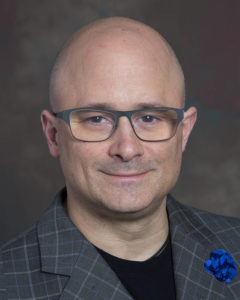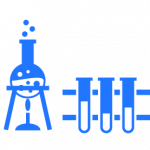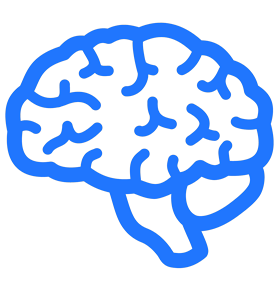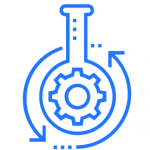Dr. Ken Mackie is a Professor of Psychological and Brain Sciences at Indiana University, Bloomington, IN (IUB) and an Adjunct Professor of Anesthesiology at Indiana University School of Medicine. He is also the Linda and Jack Gill Chair of Neuroscience and the Director of the Gill Center for Biomolecular Science at IUB.
Professor Mackie’s research is focused on cannabinoid receptors, the cell surface receptors responsible for most of the psychoactive and therapeutic actions. His team at the Gill Center for Biomolecular Science uses a variety of techniques, including electrophysiological, molecular, immunological, and imaging, to better understand how cannabinoid receptors signal and how their signaling interacts with other cellular processes. Much of the current work in his lab centers on endogenous cannabinoids (endocannabinoids), compounds produced by the body that interact with cannabinoid receptors. These molecules have been implicated in processes as diverse as memory, analgesia, anxiety, schizophrenia, and obesity. One of the recent results from his group suggests that cannabis produces some of its effects by blocking the normal actions of endocannabinoids. This contrasts with the mode of action of opiates, which appear to produce their psychoactivity by mimicking the effects of endogenous opiates (endorphins).
Dr. Mackie received his MD from Yale University, and completed his Internal Medicine Internship in the Yale system and Anesthesiology Residency at the University of Washington. He did post-doctoral work at Rockefeller University and the University of Washington. For fifteen years he combined an active laboratory research program in cannabinoid research with clinical care in anesthesiology at the University of Washington. In 2007 he was recruited to IUB as a Gill Chair in neuroscience. Dr. Mackie’s research interests focus on understanding the relationships between cannabinoids (such as THC and CBD), endocannabinoids, and the pharmacological and physiological responses to both. His lab takes diverse approaches (imaging, electrophysiological, behavioral, molecular, and biochemical) to address these questions. He has served on numerous national and international review boards and has taken an active role in organizing cannabinoid-themed meetings. Dr. Mackie is a member of several professional societies including the Society for Neuroscience, the American Society for Pharmacology and Experimental Therapeutics, the International Cannabinoid Research Society, and the American Society of Anesthesiologists.
Representative Publications:
Morgan, D.J., B.J. Davis, C.S. Kearn, D. Marcus, A.J. Cook, J. Wager-Miller, A. Straiker, M.H. Myoga, J. Karduck, E. Leishman, L.J. Sim-Selley, T.A. Czyzyk, H.B. Bradshaw, D.E. Selley, and K. Mackie, Mutation of Putative GRK Phosphorylation Sites in the Cannabinoid Receptor 1 (CB1R) Confers Resistance to Cannabinoid Tolerance and Hypersensitivity to Cannabinoids in Mice. J Neurosci, 2014. 34(15): p. 5152-63.
Ramikie, T.S., R. Nyilas, R.J. Bluett, J.C. Gamble-George, N.D. Hartley, K. Mackie, M. Watanabe, I. Katona, and S. Patel, Multiple mechanistically distinct modes of endocannabinoid mobilization at central amygdala glutamatergic synapses. Neuron, 2014. 81(5): p. 1111-25.
O’Donnell, B.F. and K. Mackie, The mismatch negativity: a translational probe of auditory processing in cannabis users. Biol Psychiatry, 2014. 75(6): p. 428-9.
Petrov, R.R., L. Knight, S.R. Chen, J. Wager-Miller, S.W. McDaniel, F. Diaz, F. Barth, H.L. Pan, K. Mackie, C.N. Cavasotto, and P. Diaz, Mastering tricyclic ring systems for desirable functional cannabinoid activity. Eur J Med Chem, 2013. 69: p. 881-907.
Chen, D.H., A. Naydenov, J.L. Blankman, H.C. Mefford, M. Davis, Y. Sul, A.S. Barloon, E. Bonkowski, J. Wolff, M. Matsushita, C. Smith, B.F. Cravatt, K. Mackie, W.H. Raskind, N. Stella, and T.D. Bird, Two novel mutations in ABHD12: expansion of the mutation spectrum in PHARC and assessment of their functional effects. Hum Mutat, 2013. 34(12): p. 1672-8.
Jain, T., J. Wager-Miller, K. Mackie, and A. Straiker, Diacylglycerol lipasealpha (DAGLalpha) and DAGLbeta cooperatively regulate the production of 2-arachidonoyl glycerol in autaptic hippocampal neurons. Mol Pharmacol, 2013. 84(2): p. 296-302.
Cristino, L., G. Busetto, R. Imperatore, I. Ferrandino, L. Palomba, C. Silvestri, S. Petrosino, P. Orlando, M. Bentivoglio, K. Mackie, and V. Di Marzo, Obesity-driven synaptic remodeling affects endocannabinoid control of orexinergic neurons. Proc Natl Acad Sci U S A, 2013. 110(24): p. E2229-38.
Straiker, A., K.T. Min, and K. Mackie, Fmr1 deletion enhances and ultimately desensitizes CB(1) signaling in autaptic hippocampal neurons. Neurobiol Dis, 2013. 56: p. 1-5.
Shonesy, B.C., X. Wang, K.L. Rose, T.S. Ramikie, V.S. Cavener, T. Rentz, A.J. Baucum, 2nd, N. Jalan-Sakrikar, K. Mackie, D.G. Winder, S. Patel, and R.J. Colbran, CaMKII regulates diacylglycerol lipase-alpha and striatal endocannabinoid signaling. Nat Neurosci, 2013. 16(4): p. 456-63.
Keimpema, E., G. Tortoriello, A. Alpar, S. Capsoni, I. Arisi, D. Calvigioni, S.S. Hu, A. Cattaneo, P. Doherty, K. Mackie, and T. Harkany, Nerve growth factor scales endocannabinoid signaling by regulating monoacylglycerol lipase turnover in developing cholinergic neurons. Proc Natl Acad Sci U S A, 2013. 110(5): p. 1935-40.
Atwood, B.K., A. Straiker, and K. Mackie, CB(2) cannabinoid receptors inhibit synaptic transmission when expressed in cultured autaptic neurons. Neuropharmacology, 2012. 63(4): p. 514-23.
Atwood, B.K., A. Straiker, and K. Mackie, CB(2): therapeutic target-in-waiting. Prog Neuropsychopharmacol Biol Psychiatry, 2012. 38(1): p. 16-20.
Atwood, B.K., J. Wager-Miller, C. Haskins, A. Straiker, and K. Mackie, Functional selectivity in CB(2) cannabinoid receptor signaling and regulation: implications for the therapeutic potential of CB(2) ligands. Mol Pharmacol, 2012. 81(2): p. 250-63.
Straiker, A., J. Wager-Miller, J. Hutchens, and K. Mackie, Differential signalling in human cannabinoid CB1 receptors and their splice variants in autaptic hippocampal neurones. Br J Pharmacol, 2012. 165(8): p. 2660-71.
Straiker, A., J. Wager-Miller, and K. Mackie, The CB1 cannabinoid receptor C-terminus regulates receptor desensitization in autaptic hippocampal neurones. Br J Pharmacol, 2012. 165(8): p. 2652-9.
Ho, Y.C., H.J. Lee, L.W. Tung, Y.Y. Liao, S.Y. Fu, S.F. Teng, H.T. Liao, K. Mackie, and L.C. Chiou, Activation of orexin 1 receptors in the periaqueductal gray of male rats leads to antinociception via retrograde endocannabinoid (2-arachidonoylglycerol)-induced disinhibition. J Neurosci, 2011. 31(41): p. 14600-10.
Straiker, A., J. Wager-Miller, S.S. Hu, J.L. Blankman, B.F. Cravatt, and K. Mackie, COX-2 and fatty acid amide hydrolase can regulate the time course of depolarization-induced suppression of excitation. Br J Pharmacol, 2011. 164(6): p. 1672-83.
Atwood, B.K., D. Lee, A. Straiker, T.S. Widlanski, and K. Mackie, CP47,497-C8 and JWH073, commonly found in ‘Spice’ herbal blends, are potent and efficacious CB(1) cannabinoid receptor agonists. Eur J Pharmacol, 2011. 659(2-3): p. 139-45.
Wu, C.S., J. Zhu, J. Wager-Miller, S. Wang, D. O’Leary, K. Monory, B. Lutz, K. Mackie, and H.C. Lu, Requirement of cannabinoid CB(1) receptors in cortical pyramidal neurons for appropriate development of corticothalamic and thalamocortical projections. Eur J Neurosci, 2010. 32(5): p. 693-706.
Marrs, W.R., J.L. Blankman, E.A. Horne, A. Thomazeau, Y.H. Lin, J. Coy, A.L. Bodor, G.G. Muccioli, S.S. Hu, G. Woodruff, S. Fung, M. Lafourcade, J.P. Alexander, J.Z. Long, W. Li, C. Xu, T. Moller, K. Mackie, O.J. Manzoni, B.F. Cravatt, and N. Stella, The serine hydrolase ABHD6 controls the accumulation and efficacy of 2-AG at cannabinoid receptors. Nat Neurosci, 2010. 13(8): p. 951-7.
Atwood, B.K. and K. Mackie, CB2: a cannabinoid receptor with an identity crisis. Br J Pharmacol, 2010. 160(3): p. 467-79.
Atwood, B.K., J. Huffman, A. Straiker, and K. Mackie, JWH018, a common constituent of ‘Spice’ herbal blends, is a potent and efficacious cannabinoid CB receptor agonist. Br J Pharmacol, 2010. 160(3): p. 585-93.
Straiker, A., S.S. Hu, J.Z. Long, A. Arnold, J. Wager-Miller, B.F. Cravatt, and K. Mackie, Monoacylglycerol lipase limits the duration of endocannabinoid-mediated depolarization-induced suppression of excitation in autaptic hippocampal neurons. Mol Pharmacol, 2009. 76(6): p. 1220-7.
Straiker, A. and K. Mackie, Cannabinoid signaling in inhibitory autaptic hippocampal neurons. Neuroscience, 2009. 163(1): p. 190-201.
Kellogg, R., K. Mackie, and A. Straiker, Cannabinoid CB1 receptor-dependent long-term depression in autaptic excitatory neurons. J Neurophysiol, 2009. 102(2): p. 1160-71.
Daigle, T.L., M.L. Kwok, and K. Mackie, Regulation of CB1 cannabinoid receptor internalization by a promiscuous phosphorylation-dependent mechanism. J Neurochem, 2008. 106(1): p. 70-82.















